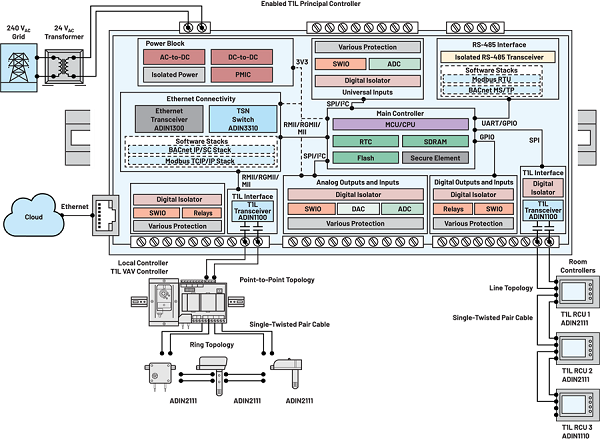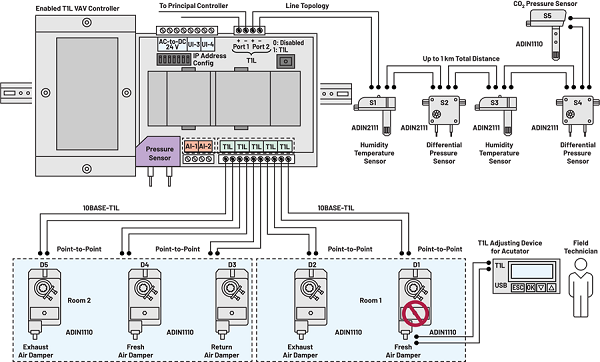Salem Gharbi, Analog Devices
Building operators are searching for technologies that allow them to meet sustainability and energy efficiency goals by leveraging operational data to optimize systems like heating, ventilation, and air conditioning (HVAC) and lighting. To fully capture the value of that data, advanced connectivity and control systems will be crucial. This article highlights the benefits of using Ethernet direct digital controllers (DDCs), also known as building controllers, in building management systems (BMSs) and explains how the 10BASE-T1L protocol can fit into a typical BMS architecture. With its 10 Mbps data rate, support for various topologies, and power over a single-twisted pair cable, 10BASE-T1L provides seamless Ethernet connectivity to DDC controllers and edge nodes in point-to-point, ring, and line network configurations. It offers real-time control and overcomes the limitations of previous protocols while supporting virtually unlimited numbers of edge nodes. Its ability to transmit data over long distances up to 1 km makes it an ideal retrofit solution for existing BMSs as it can reuse existing single-twisted pair cabling. Its features eliminate the need for power-hungry gateways, enabling seamless edge-to-cloud connectivity. This makes it a valuable resource for those interested in the latest BMS technology, capturing new insights on their building’s operation, and in the potential to optimize energy efficiency.
T1L-Enabled DDC
DDC systems are essential for modern building management, allowing real-time monitoring and control of various building systems. As technology advances, Ethernet-connected DDC systems will become more widespread, further improving the efficiency and safety of buildings. The ADIN1100 PHY, ADIN1110 MAC PHY, and ADIN2111 two-port switch from Analog Devices are ideal solutions for adding 10BASE-T1L to a DDC system. This technology enables the transmission of process values, configuration information, software updates, and diagnostics, making it easier to manage and maintain building systems. With a cable length of up to 1 km, 10BASE-T1L is equipped with diagnostic features that allow for quick and efficient resolution of any faults in the system. The integration of 10BASE-T1L with software stacks such as Modbus IP and BACnet IP provides a comprehensive solution for industrial automation systems, facilitating efficient data collection, device control, and system monitoring. Figure 1 highlights how 10BASE-T1L products can be incorporated into the HVAC controllers and room controllers to communicate with multiple room or building controllers in a ring or line topology.
To gain a comprehensive understanding and in-depth exploration of Ethernet-connected building controllers and ADI technology, we recommend checking out this educational video. This video offers valuable information and insights into the latest advancements and developments in this field.
Application: T1L-Enabled VAV Controller in HVAC System
VAV Definition
A variable air volume (VAV) system is a common HVAC device/controller used in modern office buildings with multiple systems often installed in different zones/ areas to maintain comfortable temperature levels. It allows different zones to operate at different temperatures using the same ventilation system, by varying the volume of air supplied while keeping the temperature constant. To ensure adequate ventilation, VAV systems use DDC programming, which calculates and commands the necessary damper adjustments. Modern programmable VAV zone controllers include a built-in actuator and maintain zone temperature by operating the terminal fan and regulating the flow of conditioned air into the space. They provide dedicated control functions for single duct, parallel fan box terminals, and series fan box terminals with modulating heat. The controller is composed of two main blocks: the damper actuator and an integrated programmable DDC. It also supports the interface of different sensors needed to correctly adjust the volume and monitor the quality of air in VAV applications. The programmable VAV zone controller can measure and display zone temperature, detect occupancy, measure duct temperature, measure discharge air temperatures, measure zone humidity and dewpoint determinations, detect CO2 levels, and control the AV box fan speed. The use of 10BASE-T1L controllers in large buildings such as airports can provide optimal energy efficiency and indoor air quality, while also reducing maintenance and operating costs.

Use Case Example in Large Buildings
For this application, we will focus on a specific zone in an airport, as illustrated in Figure 2. However, it’s important to note that the VAV system and control algorithms described here can be applied to other large buildings as well. This zone has two rooms, and the VAV system is using five sensors and actuators positioned in different locations across the ductwork of the same zone. In the first room, two actuators (D1 and D2), a temperature sensor (S1), and a pressure sensor (S2) are used. S1 and S2 are in the supply air duct close to the terminal, and they use D2 as an exhaust air damper and D1 as a fresh air damper to control the airflow of the room. Similarly, in the second room, the same number of sensors and actuators (D3, D4, S3, S4) are used, but due to the extra load in the room, a CO2 sensor (S5) and an extra actuator (D5) are added in the return air duct to provide better control of the airflow and quality. The VAV control unit uses control loop algorithms to monitor and control the sensors and actuators. It modulates the damper position based on the readings from the temperature and pressure sensors and then acts based on how it was programmed. For example, if the temperature changes in room one, the VAV unit will start to open and close dampers D1 and D2, causing a pressure change in the supply air duct, which can be detected using S2. If the pressure increases, the VAV unit will notice that change and slow down the fan located in the air handling unit (AHU).
All the sensors are connected in a line topology and positioned in different locations of the ductwork. Each damper is connected directly from the VAV unit using a point-to-point topology. Existing infrastructure is severely limited based on the restrictions of the cable length, impedance, thickness, and most importantly, the system DC loop resistance. However to solve these issues, 10BASE-T1L DDC controllers can be used to provide real-time control of sensors and actuators network over 1 km using only a single-twisted pair of cable. In addition, the 10BASE-T1L adjusting device actuator can be configured remotely to fine tune the run time and the position of the damper to a minimum set point. It can also be used to evaluate the damper in case of failure. The VAV system is a powerful tool for maintaining a comfortable environment in large buildings such as airports. By using sensors and actuators positioned in different locations, the VAV unit can modulate the airflow and quality to maintain a consistent temperature and pressure. With the help of advanced technology like the 10BASE-T1L DDC controllers, the HVAC system can be controlled and maintained while providing valuable energy savings for improved efficiency.

Conclusion
Adding 10BASE-T1L to the building controller removes the need for complex power-hungry gateways and enhances the BMS by providing real-time control of sensors and actuators over long distance using a single-twisted pair cable. Building controllers are able to achieve longer reach with a virtually unlimited number of edge devices depending on the network performance and requirements. 10BASE-T1L-enabled building controllers are also able to monitor the network failures and define cabling issues using fault detection and cable diagnostics features.
Author
Salem Gharbi is a systems applications engineer with Analog Devices in the Sustainable Buildings and Infrastructure Business Unit. Salem has 7 years of experience working in a diverse set of IoT and industrial applications. He is responsible for delivering industrial automation focused, system-level solutions.






